Your cart is currently empty!
Author: Kate Romeo
-

Common Chemicals Used in Metal Finishing
Metal finishing is a common process for polishing and reinforcing materials in a variety of industries. Some metal finishing methods utilize specific chemicals to provide surface finishing. From plating shops and manufacturing to large-scale foundries, this type of finishing occurs in many industries. Keep reading to learn more about the metal finishing processes and the common chemicals professionals use to complete them.
Different Types of Metal Finishing Processes
Industries use many types of metal finishing processes. Some of these methods include electroplating, powder coating, anodizing, electropolishing, grinding, sandblasting, and vibratory finishing. The metal finishing process promotes a thin coating on metal materials to help enhance their appearance and strengthen them against corrosion and wear and tear. Other methods utilize chemical materials to plate and finish the surface of the material. These are specialty chemicals that provide surface finishing to deliver aesthetic and functional benefits for metal surfaces.
Common Metal Finishing Chemicals
The main types of metal finishing chemicals are plating chemicals, cleaning chemicals, proprietary chemicals, and those used for conversion coating. Various industries and manufacturers use these chemicals to clean and finish metal parts through electroplating and additional treatment methods. Some of the most common chemicals for various metal finishing processes include:
- Nitric Acid
- Sulfuric Acid
- Chromic Acid
- Hydrochloric Acid
- Phosphoric Acid
- Sodium Hydroxide
Professional chemical suppliers such as Post Apple Scientific offer sulfuric acid for sale and other finishing chemicals so that these industries have a secure and trustworthy source for these materials.
Examples of Metal Finishing Applications
The demand for metal finishing and the chemicals involved is growing throughout many industries. Some common industries that utilize metal finishing chemicals include aerospace, automotive, transportation, electronics, packaging, construction, and heavy equipment manufacturing, among many others. This process helps create stronger, more resistant surfaces that hold up against difficult conditions such as corrosion and daily wear and tear, which is useful in endless applications. Surface finishing helps provide a clean, polished surface for a wide variety of products in these industries.
Now that you know more about the metal finishing process and the common chemicals required for these methods, you may consider securing these materials for your own business’s use. If you’re looking for a trustworthy supplier for sulfuric acid and other metal finishing chemicals, browse our website at Post Apple Scientific today. We supply high-quality chemicals for laboratories, manufacturers, and many other industries and applications.
-

How Chemistry Is Used in the Automotive Industry
Chemistry influences many more industries than the average consumer realizes. For example, did you know that chemistry plays a large role in the production and function of cars and other vehicles? Keep reading to discover how chemistry is used in the automotive industry and why it is so important to the vehicles we drive today.
Vehicle Fuel Efficiency and Function
A vehicle’s fuel efficiency is heavily dependent on its weight and the materials that go into making it. Chemically manufactured plastics and other innovative materials can help reduce a vehicle’s weight compared to traditional manufacturing materials made of heavier organic materials. Additionally, the fuel sources in many vehicles are based on chemical reactions, whether they run on gasoline, electricity, fuel cells, or diesel as a fuel source.
Automotive Safety Components
We couldn’t have safe vehicle components without chemicals. Vehicle safety components are often made from chemical-based materials such as polymers and plastics. For example, children’s safety seats come from polymer science advancements. Seatbelts are another common example of chemical-based materials, as they are manufactured from polyester fibers, which make them durable and strong. Even airbags rely on chemical reactions to rapidly release nitrogen so that they can reliably deploy during certain types of collisions.
Vehicle Design and Comfort
Finally, chemical-based materials are present everywhere in vehicle design and aesthetics. Everything from a car’s exterior paint to its cushioned seats are made thanks to polyurethanes and other chemical-based materials. High-durability plastics and polymers are used in vehicle exteriors to prevent damage during accidents and everyday mishaps that could normally cause scratches or dents. Even the seat cushions inside your vehicle and their upholstery come from polyester fibers and other manufactured materials to help your car’s interior be more durable and withstand years of travel.
These are just a few of the many ways chemistry can be used in the automotive industry. Whether you work in the automotive industry or other manufacturing branches, you can trust Post Apple Scientific if you’re looking for a chemical solvent supplier for applications such as these. Our supply shop provides utensils and chemicals for a variety of industries, including vehicle manufacturing and other types of commercial needs.
-
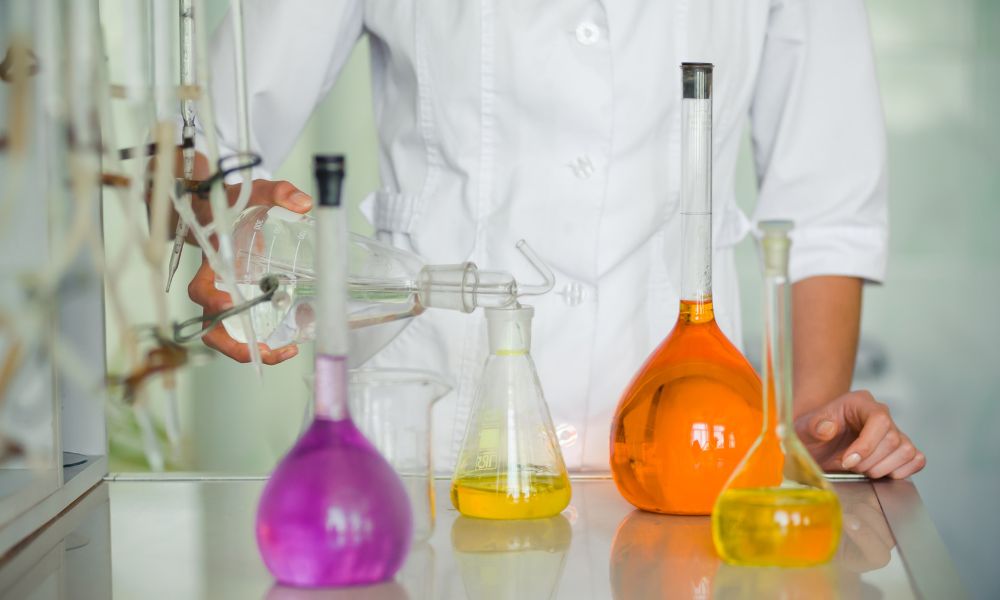
Tips & Tricks for a Successful Titration Experiment
Titration experiments are an important part of many chemical lab studies. This process helps you understand the chemicals and other solutions involved in your experiments. Use these tips and tricks to promote successful titration experiments in the future.
What Is Titration?
It’s important to understand the basics of titration in the first place if you want to have a successful experiment. Titration is a process that involves adding a solution of a known concentration (the titrant) to an unknown solution (the titrand). Various industries utilize this process to discover the concentration of an unknown solution, though it is especially common in chemistry and other lab science applications. As with any laboratory process, several factors can affect the success of titration, but using the following tips and tricks can help promote a more accurate process.
Standardize Your Titrant
After certain periods of time, your titrant can change in concentration. This change could lead to inaccurate readings during the titration process, which is why it’s important to standardize your titrant regularly. Develop a regular standardization process to ensure that your titration results are accurate based on your known solution. Some laboratories test their titrants on a weekly basis, though the necessary frequency can also depend on how often you use these solutions for titration. Make sure to note your last standardization test by keeping a log.
Use the Right pH Electrode
Technicians use pH electrodes to test solutions during the titration process. The type of pH electrode you use can influence the success of this process. For example, the best pH electrodes will respond rapidly to the smallest pH changes, allowing you to get an accurate recording of concentration changes. Even once you select your pH electrode, remember to calibrate it regularly and schedule maintenance when needed.
Following these tips and tricks can help your future titration experiments be successful. When you need materials for chemical analysis, such as titration experiments, turn to Post Apple Scientific. We are a chemical reagent supplier, and we offer a wide range of laboratory chemicals and materials. You can find everything you need for a successful experiment at Post Apple Scientific.
-

How To Measure the Rate of a Chemical Reaction
Understanding how to measure the rate of a chemical reaction is fundamental to many scientific and industrial processes. From developing new drugs to producing plastics, reaction rates are crucial in determining how quickly these reactions occur. Read here and find out how to measure the rate of chemical reactions.
Why Chemical Reaction Rates Matter
The rate of a chemical reaction can be as important as the resultsof that reaction—here’s why.
Influence on Biological Systems
The workings of our bodies hinge on countless chemical reactions, all happening simultaneously. Enzymes catalyzing metabolic reactions, the synthesis of DNA, and the action of neurotransmitters all occur at specific rates. If these rates were too fast or slow, our bodies wouldn’t function properly, leading to disease or even death. Understanding reaction rates at a biological level is thus crucial for medical and biological research.
Significance in Environmental Chemistry
The rate of chemical reactions governs many environmental processes. Decomposition rates of organic matter, the ozone layer’s photochemical reactions, or the carbon cycle’s chemical reactions are all instances where knowing the reaction rate is crucial. Understanding these rates is essential for predicting environmental changes, mitigating pollution, and implementing sustainable practices.
Impact on Food and Agriculture
In food production and agriculture, knowing the rate of chemical reactions is vital. It aids in predicting the shelf life of food products, understanding how cooking alters food chemistry, and optimizing fertilizer usage for crops. Here, the knowledge of reaction rates ensures food safety, quality, and agricultural sustainability.
Role in Material Science
Understanding reaction rates in material science is key to designing and predicting the behavior of materials. Whether it’s the corrosion of metals, the curing of concrete, or the aging of polymers, the rate of these reactions determines the lifespan and safety of materials that build our world.
Importance in Energy Production
In the field of energy production, be it fossil fuel combustion or nuclear reactions, the rate of reactions dictates the energy output, efficiency, and safety of these processes. Mastering reaction rates is crucial for engineering safer, more efficient, and sustainable energy solutions.
Monitoring Concentration Over Time
One primary method for measuring the rate of a chemical reaction involves monitoring the concentration of a reactant or product over time. By measuring how the concentration of a substance changes, we can calculate the rate of the reaction. This technique typically involves spectroscopy or chromatography, which allows scientists to observe these changes in concentration in real time.
Using Reaction Rate Laws
Reaction rate laws, derived from the balanced chemical equation of a reaction, can also provide valuable insight into the rate of a chemical reaction. By understanding the relationship between the rate of a reaction and the concentration of its reactants, these laws allow us to predict how a reaction will proceed under various conditions. They are crucial in helping chemists optimize conditions for desired chemical reactions.
Temperature Effects
Temperature is a significant factor affecting the rate of a chemical reaction. As the temperature increases, the average kinetic energy of the particles also rises, leading to more collisions and, thus, a faster reaction rate. By controlling and measuring temperature changes, one can gather information about a reaction’s speed and control the reaction rate to an extent.
Pressure Effects
Like temperature, pressure can also dramatically impact the rate of a chemical reaction, especially for reactions involving gases. As pressure increases, molecules get forced closer together, leading to a higher collision frequency and, subsequently, a faster reaction rate. By adjusting and measuring pressure changes, we can gain additional insight into a reaction’s rate and optimize conditions for industrial chemical reactions.
Using Catalysts
Catalysts are substances that speed up a chemical reaction without getting consumed by the reaction itself. They do this by providing an alternative reaction pathway with lower activation energy. By measuring the reaction rate with and without the presence of a catalyst, we can understand the catalyst’s effect.
Collision Theory
Collision theory provides a model for understanding reaction rates by considering how reactant particles collide. The theory states that for a reaction to occur, particles must collide with the correct orientation and sufficient energy to break existing bonds and form new ones. By considering factors such as concentration, pressure, and temperature, collision theory allows us to predict and understand reaction rates.
Activation Energy and Arrhenius Equation
The Arrhenius Equation is a mathematical model that relates the rate of a chemical reaction to temperature and activation energy. Activation energy is the minimum energy required for a chemical reaction to occur. By measuring how the rate changes with temperature, we can determine the activation energy, providing crucial information about the reaction mechanism.
Measuring Reaction Rates With Spectroscopy
Spectroscopic methods can provide precise measurements of reaction rates. These methods work by observing changes in light absorption or emission related to concentration changes of the reactants or products. For instance, UV-Vis spectroscopy can monitor changes in color, while IR spectroscopy can track changes in bond vibrations.
Rate-Determining Step in Multi-Step Reactions
In multi-step reactions, one step often determines the overall rate of the reaction, known as the rate-determining step. This step is the slowest and therefore limits the speed at which the entire reaction can proceed. By identifying and studying this step, scientists can gain deeper insights into the kinetics of complex reactions.
Isotopic Labeling
Isotopic labeling is a technique used to track the movement of atoms during a chemical reaction. By replacing a regular atom in a reactant with an isotopic atom, scientists can observe how it moves during the reaction, providing information about the reaction mechanism and rate.
Now that you know how to measure the rate of a chemical reaction, you’re equipped with the foundational understanding required to further explore the complexities of chemical kinetics. Whether you’re intrigued by how temperature affects a reaction or curious about the impact of a catalyst, you’re now well-versed in the factors that influence reaction rates.
Understanding these techniques doesn’t just give you insight into the theoretical world of chemistry; it also opens the door to practical applications, from optimizing industrial processes to developing cutting-edge pharmaceuticals. No matter what you use this information for, you can count on Post Apple Scientific as your online chemical supply store!
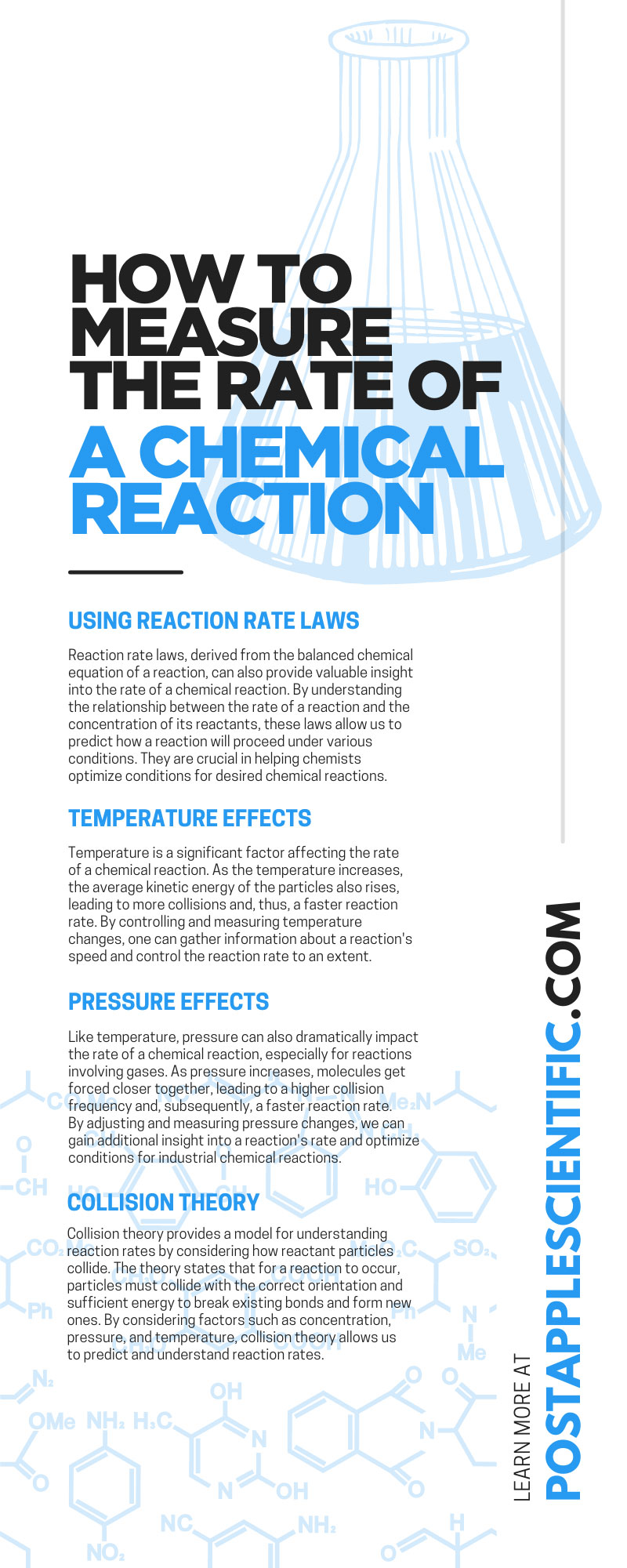
-

Common Chemicals Used in the Pharmaceutical Industry
[et_pb_section fb_built=”1″ _builder_version=”4.21.0″ _module_preset=”default” global_colors_info=”{}”][et_pb_row _builder_version=”4.21.0″ _module_preset=”default” global_colors_info=”{}”][et_pb_column type=”4_4″ _builder_version=”4.21.0″ _module_preset=”default” global_colors_info=”{}”][et_pb_text _builder_version=”4.21.0″ _module_preset=”default” global_colors_info=”{}”]
The pharmaceutical industry relies heavily on a myriad of chemicals for the development, production, and preservation of drugs. These chemicals serve critical roles in drug efficacy, safety, and overall quality. Read on to discover four common chemicals used in the pharmaceutical industry.
Active Pharmaceutical Ingredients (APIs)
Active Pharmaceutical Ingredients (APIs) are the heart of any drug, responsible for an intended therapeutic effect. They are specific chemicals or combinations of chemicals that interact with a patient’s body to treat or manage a condition. The composition, structure, and concentration of APIs dictate the effectiveness of the medication.
Excipients
In contrast to APIs, excipients don’t have therapeutic effects, but they’re equally important. Scientists use these substances alongside the active ingredient to enhance drug delivery or stability. Excipients can control the drug release rate, improve absorption, or provide the drug with a suitable form such as tablets or capsules.
Solvents
Scientists use solvents to dissolve or dilute other substances without altering their properties, making them crucial in drug formulation. Water is the most common solvent in the pharmaceutical industry due to its non-toxic nature. However, other solvents like ethanol and acetone also have wide applications.
Preservatives
Preservatives prevent the growth of bacteria and fungi, ensuring the product’s longevity and safety. Common preservatives include parabens, benzyl alcohol, and phenol. However, scientists strictly regulate the use of preservatives to ensure they don’t compromise the product’s safety or efficacy.
No matter the scientific chemicals you require for your pharmaceutical needs or other applications, you can count on Post Apple Scientific—we have the chemicals you need.
Now that you know these four common chemicals used in the pharmaceutical industry, you can appreciate the intricacy and precision behind drug development and production. Each chemical, whether it’s an active ingredient, an excipient, a solvent, or a preservative, contributes to the effectiveness, safety, and stability of the medications we use daily. The meticulous balancing act of these components underscores the importance of chemical expertise in pharmaceutical science.
[/et_pb_text][/et_pb_column][/et_pb_row][/et_pb_section]
-

4 Tips for Managing Varroa Mites in Honey Bee Colonies
Varroa mites pose a significant threat to honey bee colonies, affecting their health and productivity. As a beekeeper, it’s crucial to develop strategies to manage and control these mites to maintain the health of your colonies. Here are four tips that can help you manage Varroa mites in honey bee colonies.
Regular Monitoring
The first step to controlling Varroa mites is regular monitoring. By checking your hives consistently, you’ll be able to identify an infestation early. This will allow you to take immediate action, thereby preventing the mites from causing extensive damage to your colonies. Monitoring methods include drone brood sampling and powdered sugar roll.
Using Screened Bottom Boards
Screened bottom boards can be an effective tool in your fight against Varroa mites. These boards have a mesh screen that allows the mites to fall through, but not the bees. Once the mites fall through, they’re unable to climb back into the hive, reducing the mite population within the colony.
Combining Mite-Resistant Bees With Drone Brood Trapping
A natural way to control mites is by incorporating mite-resistant bees into your hives and practicing drone brood trapping. Mite-resistant bees have traits that help them resist and survive mite infestations. Drone brood trapping involves removing drone combs (which attract mites) from your hive, thereby removing many mites along with it.
Use of Oxalic Acid
Oxalic acid is a popular and effective treatment against Varroa mites. It’s an organic compound found naturally in plants and is safe for bees but lethal to mites. The acid can be applied in several ways, including as a spray or drip, and it’s most effective when the colony has little or no capped brood. When you need oxalic acid for sale, you can always count on Post Apple Scientific!
Now that you have these four tips for managing Varroa mites in honey bee colonies, you’re well-equipped to maintain healthy and productive hives. Remember, early detection and consistent management practices are key in the battle against Varroa mites.
-
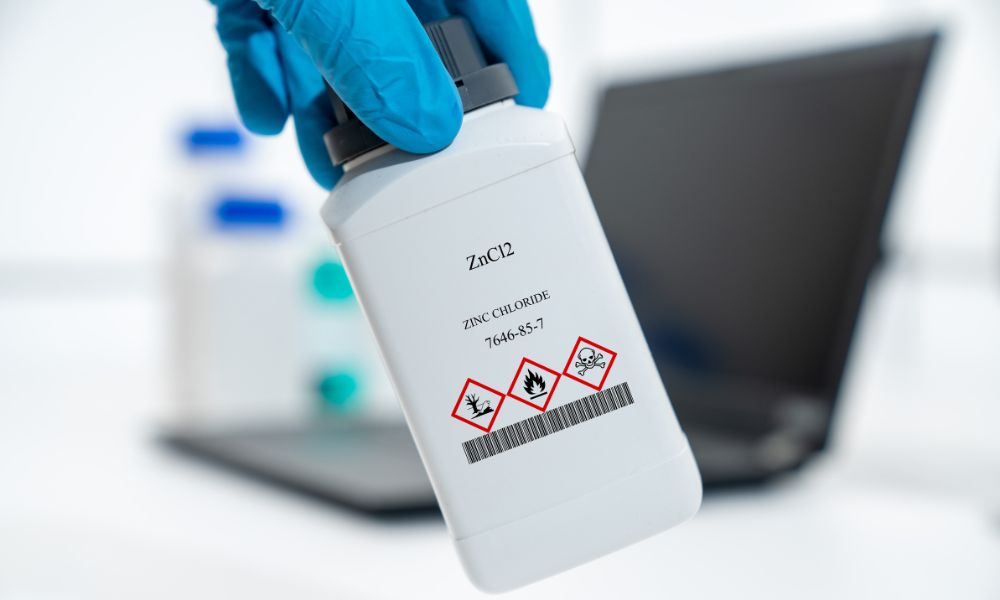
4 Things To Consider When Purchasing Chemicals
When you’re in a business that requires purchasing chemicals, there’s a lot more that goes into the decision-making process than simply finding the right supplier. In fact, there are several things to consider when purchasing chemicals to ensure you’re making a responsible, safe, and economical choice.
Your Requirements
The first thing you need to consider is the precise nature of your requirements. This not only includes the type of chemical you need, such as zinc chloride or sodium bicarbonate, but also the grade, concentration, and quantity. It’s essential to understand your requirements in detail, as this will significantly impact the supplier you choose, the price you pay, and the safety precautions you need to implement.
Quality Assurance
The quality of the chemicals you purchase is a crucial factor that cannot be ignored. Poor-quality chemicals can lead to inaccurate results, damaged equipment, or even safety hazards. Ensure that your supplier adheres to industry standards for quality assurance and can provide proof of compliance. This can include things like ISO certification, third-party testing results, and other industry-specific qualifications.
Your Supplier’s Reputation and Reliability
When choosing a supplier, their reputation and reliability matter a lot. You want to work with a supplier that can consistently deliver high-quality chemicals on time. This is crucial because any delays or inconsistencies can disrupt your operations and cause unnecessary complications. A supplier with a good reputation is more likely to be reliable, trustworthy, and committed to customer satisfaction.
Online Purchasing and Delivery Options
In today’s digital era, the ability to buy zinc chloride online, as well as other chemicals, is a significant advantage. It offers convenience, more competitive pricing, and the opportunity to review detailed product specifications and safety data at your leisure. As you look for chemicals, you also need to consider the supplier’s delivery capabilities. They should be able to safely transport the chemicals to your location while adhering to all relevant regulations.
Now that you know these four things to consider when purchasing chemicals, you’re better equipped to make an informed decision when it comes to buying the chemicals you need.
-

The Ever-Growing Role of Pyridine in Modern Chemistry
One of the most important substances in the world of modern chemistry is pyridine. This simple yet potent organic compound finds its place in numerous industrial applications, demonstrating its importance in today’s chemical landscape. Read on to discover the ever-growing role of pyridine in modern chemistry, including its uses, the benefits it brings, and the considerations one must keep in mind while using it.
What Is Pyridine?
Before we get into the uses and benefits of pyridine, it’s essential to gain a fundamental understanding of what pyridine is. This substance is a basic heterocyclic organic compound characterized by a six-membered ring composed of five carbon atoms and one nitrogen atom. The key aspect of its structure is the lone pair of electrons on the nitrogen atom, making pyridine a base.
This particular property is responsible for pyridine’s distinct, somewhat pungent odor and heavily influences its reactivity, thus dictating its wide range of applications. Pyridine is typically a colorless, flammable liquid that boils at around 115 degrees Celsius, although its form can vary based on specific uses and preparations.
Uses of Pyridine
Now that you have a basic understanding of what pyridine is, let’s discuss some of its many uses.
As a Solvent
One of the major roles pyridine plays in the modern lab is that of a solvent. Thanks to its polar nature and ability to donate and accept electrons, pyridine serves as an effective solvent for a diverse array of substances.
Pyridine can dissolve a variety of salts and polar organic molecules, making it an invaluable component in numerous chemical processes. The use of pyridine as a solvent extends to several industries, including pharmaceuticals, agrochemicals, and others, which helps prove its widespread relevance.
In the Production of Pesticides
Pyridine’s usage isn’t confined to being a solvent. It’s also a critical ingredient in the production of pesticides, providing the foundation for the synthesis of many effective pest control substances. The chemical properties of pyridine facilitate the creation of pesticides that effectively manage and eliminate various pests, thereby securing crop health and productivity.
In Pharmaceutical Applications
The pharmaceutical industry also benefits immensely from pyridine. The compound’s ability to undergo a wide array of chemical reactions makes it a crucial component in the synthesis of numerous therapeutic drugs. By acting as a chemical building block, pyridine allows for the development of complex molecular structures necessary for various pharmaceutical compounds, contributing significantly to healthcare and medicine.
In Synthetic Processes
Another arena where pyridine shines is synthetic chemistry. Pyridine’s structure and reactivity make it a versatile reagent in a plethora of synthetic procedures. It serves as a catalyst, a nucleophilic agent, and even a reducing agent in different chemical reactions. This versatility empowers chemists to design and execute complex synthetic routes, enhancing the breadth and depth of chemical synthesis.
Benefits of Pyridine
Pyridine’s utility extends beyond its chemical properties and functional roles, providing a multitude of benefits that prove its value to modern chemistry.
Versatility
One of the significant advantages of pyridine is its versatility. The compound’s ability to function as a solvent, a catalyst, and a reactant makes it a multi-functional tool in any chemist’s arsenal. This versatility translates to cost and time efficiency due to the ability to streamline processes and maximize the effectiveness of various reactions.
Adaptability
Pyridine’s reactivity can be adjusted to suit specific needs. By making slight alterations to the structure of pyridine, chemists can modulate its reactivity, enhancing the efficiency and specificity of reactions. This adaptability is a major advantage in both research and industrial applications, where the ability to design tailored solutions can often determine the success or failure of a project.
Practicality
Another benefit of pyridine is its practicality. Its ready availability and relative ease of handling ensure that pyridine can be incorporated into various processes without significant logistical hurdles. This makes it a logical choice across a wide range of sectors, from laboratory research to large-scale industrial processes.
Contribution to Innovative Research and Development
The use of pyridine has greatly facilitated innovative research and development in various industries, such as pharmaceuticals and agrochemicals. Its unique properties have led to breakthroughs in the synthesis of new compounds and the development of new synthetic routes. Therefore, pyridine is not just a tool, but also a catalyst for innovation in modern chemistry.
Considerations When Using Pyridine
Pyridine is beneficial in several respects, but there are still important considerations to bear in mind when using it.
Safety Precautions
First and foremost, those working with pyridine must adhere to safety precautions meticulously. Pyridine is a toxic substance that can cause irritation to the eyes, skin, and respiratory tract. It’s crucial to handle pyridine in a well-ventilated environment, preferably under a fume hood, wearing appropriate personal protective equipment (PPE) such as gloves and safety goggles.
Environmental Impact
Secondly, the environmental impact of pyridine must be accounted for. Improper disposal of pyridine can harm the environment, so it’s essential to follow regulatory guidelines regarding waste management. Also, consider exploring greener alternatives or recycling methods if applicable.
Storage and Stability
Finally, the storage and stability of pyridine are important factors. Pyridine should be stored in a cool, dry, well-ventilated place, away from sources of ignition and incompatible materials. Over time, pyridine can form explosive peroxides upon exposure to air, so containers should be checked periodically and tightly sealed when not in use.
The Evolving Role of Pyridine
Pyridine’s role in modern chemistry is constantly evolving as new applications and potentials are discovered. Its significant contribution to the field of pharmaceuticals, where it aids in the development of lifesaving drugs, underlines its growing importance. Moreover, its use in environmental science as a tool for pollution control further emphasizes its expanding role.
Now that you understand the ever-growing role of pyridine in modern chemistry, it’s clear to see why this versatile compound is gaining prominence. Its varied applications, from serving as a key solvent to facilitating the production of lifesaving pharmaceuticals, underscore its unique capabilities and potential for future developments.
However, as we embrace pyridine’s uses and benefits, it remains crucial to respect the safety considerations it demands, ensuring its application continues to contribute positively to our industries and environment. If you need this compound for your laboratory, Post Apple Scientific has pyridine for sale in our online store. With all the research and exploration taking place, pyridine’s role in shaping the future of modern chemistry is truly intriguing.
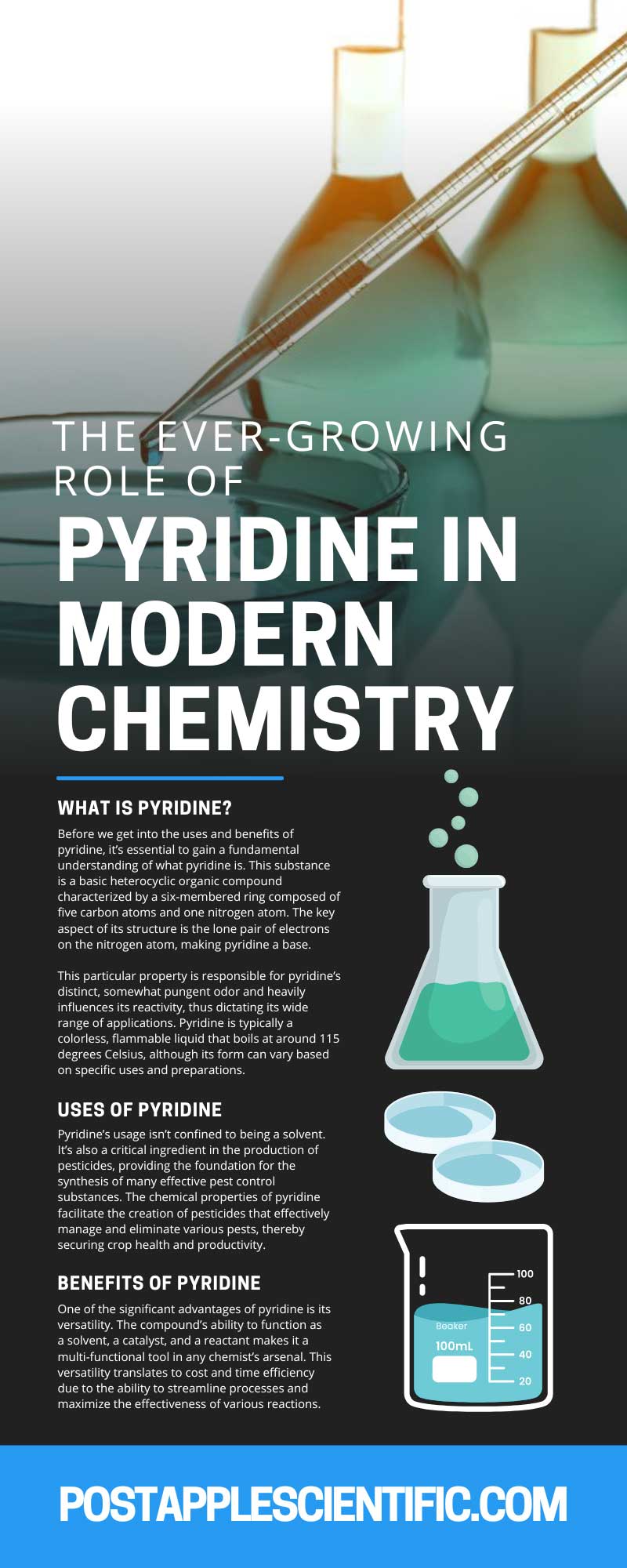
-
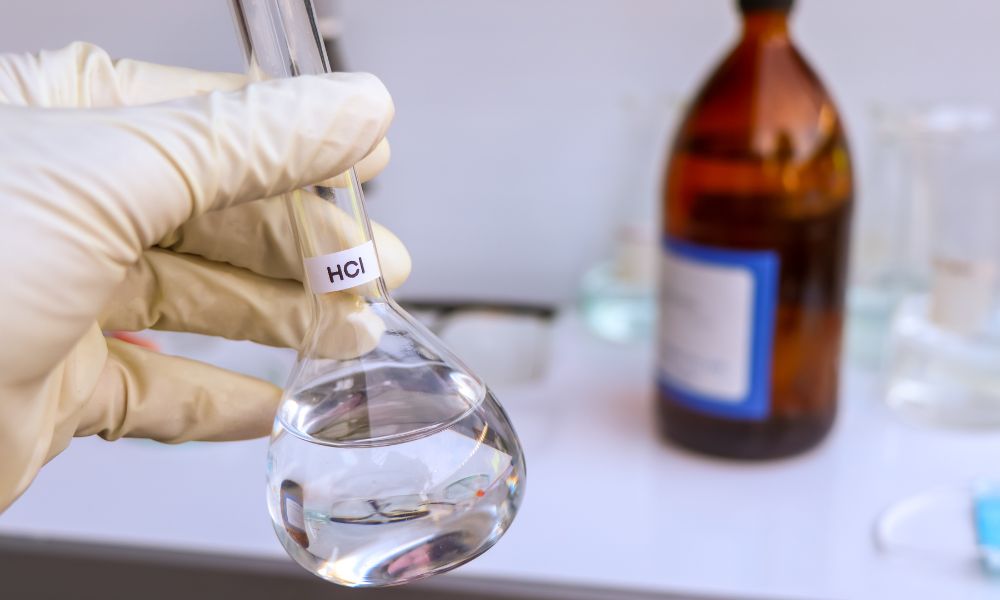
Safety Tips for Handling Hazardous Chemicals in the Lab
As a laboratory professional, you’re probably no stranger to working with hazardous chemicals. Nevertheless, their handling warrants a regular refresher to ensure safety is always at the top of your mind. Read on for some safety tips for handling hazardous chemicals in the lab.
Know Your Chemicals
Understanding your chemicals is fundamental for safe handling. Ensure you familiarize yourself with the safety data sheets (SDS) for each chemical you’re dealing with. These sheets provide detailed information on properties, hazards, safe handling procedures, and first-aid measures for each chemical. This is an integral first step in keeping yourself safe.
Wear the Right Protective Equipment
Never underestimate the power of personal protective equipment (PPE). Safety glasses, gloves, and lab coats act as a crucial line of defense when handling hazardous materials. These pieces of equipment provide an extra layer of protection from potential exposure, keeping you safe as you work.
Maintain a Clean Workspace
A well-kept workspace is an underrated aspect of lab safety. Keeping your workspace clean and organized minimizes the risk of accidents and ensures that safety equipment and exits are easily accessible in case of an emergency.
Store Chemicals Correctly
Storage can have a big impact on safety. Different chemicals require different storage conditions, and some can react dangerously when stored together. Always follow proper storage instructions to prevent hazardous situations.
Handle Hydrochloric Acid With Care
Here at Post Apple Scientific, we have hydrochloric acid for sale for your laboratory needs. When you use it, you need to remember to be extremely careful. Hydrochloric acid is useful but can be dangerous if handled incorrectly. Always use hydrochloric acid in a well-ventilated space and take measures to avoid fume inhalation.
Now that you know these safety tips for handling hazardous chemicals in the lab, you’re equipped to navigate your lab work with confidence. These practices will ensure not only a safe working environment but also an efficient lab.
-

The Best Chemicals for Critical Lab Cleaning
Cleanliness is of utmost importance in any laboratory setting. Using proper cleaning chemicals is important to maintain a sterile environment and ensure accurate results. Read on to discover the best chemicals for critical lab cleaning.
Isopropyl Alcohol (IPA)
Isopropyl alcohol is a popular cleaning agent in laboratories because it dissolves a wide range of non-polar compounds. With its quick evaporation rate, IPA leaves no residue, making it ideal for cleaning surfaces, removing contaminants, and disinfecting lab equipment.
Hydrogen Peroxide
Hydrogen peroxide is another common lab cleaning agent. Its strong oxidizing properties effectively break down organic material, kill microorganisms, and decontaminate surfaces. In addition, hydrogen peroxide is environmentally friendly, as it breaks down into water and oxygen upon contact with air.
Sodium Hypochlorite
Sodium hypochlorite, or bleach, is a powerful disinfectant used in laboratories to clean and sanitize various surfaces. It effectively kills bacteria, fungi, and viruses, ensuring a clean environment for sensitive experiments. However, it is essential to dilute sodium hypochlorite properly, as high concentrations can be corrosive and damage certain materials.
Acetone
Acetone is a versatile cleaning agent that can dissolve and remove a wide range of organic compounds, including oils, resins, and adhesives. It evaporates quickly, leaving no residue behind, making it perfect for cleaning glassware, metal surfaces, and other lab equipment. That said, it is important to handle acetone carefully, as it is highly flammable.
Ethyl Alcohol
Ethyl alcohol, or ethanol, is another effective laboratory cleaning agent. It shares many properties with isopropyl alcohol, such as quick evaporation and dissolving non-polar compounds. Ethyl alcohol is an excellent choice for cleaning surfaces, glassware, and other lab equipment without leaving any residue. Additionally, it is effectively kills bacteria and other microorganisms, ensuring a sterile laboratory environment—and you can buy ethyl alcohol online from Post Apple Scientific.
Now that you know the best chemicals for critical lab cleaning, use the appropriate solutions and keep your lab environment pristine.